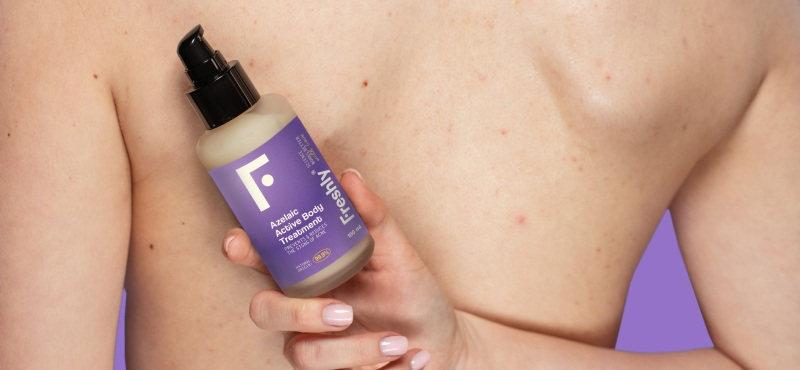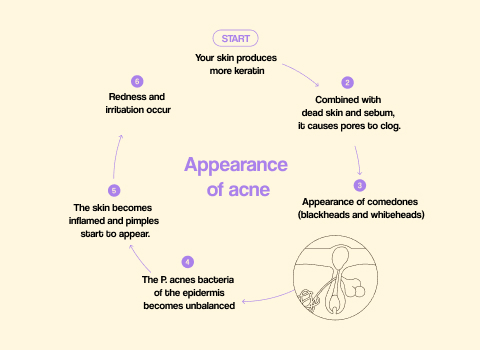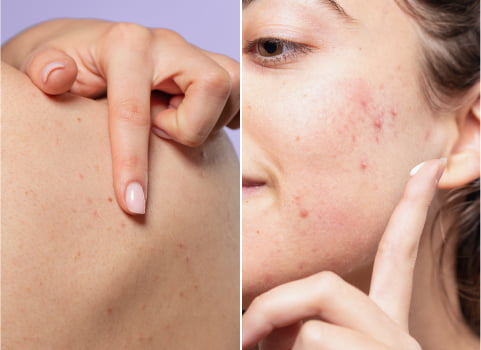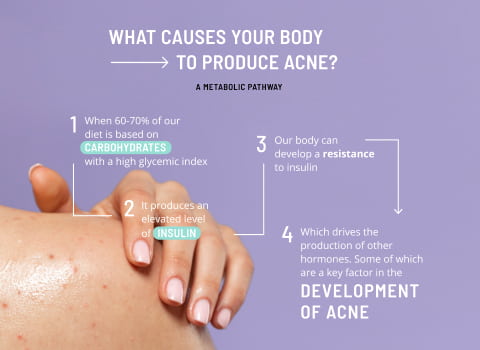Not sure what to look for? You can start from here:
The truth about acne on face & body. 3 effective solutions to clear it up

Here are your essentials
for making it this far
Acne is a common skin condition that affects many people and that has been widely researched. In fact, nowadays the causes of acne and how to avoid it are well understood, but this information is mostly glossed over and rarely emerges from scientific circles with enough clarity.
Acne usually appears on our face, forehead, chest, upper back, shoulders and – to a lesser extent – on our legs, as these areas of the skin tend to have the greatest number of sebaceous glands.
There are 3 principal factors that trigger the appearance of blackheads, spots and blemishes that are recognized as acne:
- Excess oil (sebum) production
- Hair follicles clogged by oil and dead skin cells
- Excessive buildup of bacteria and inflamed pores
So, perhaps the better question to ask is: what causes these initial factors?
We all know that teenagers tend to get acne during puberty. If we dig a little deeper, it’s quite easy to understand what causes acne breakouts. Indeed, as many of you have probably already heard, these are due to the androgens and hormones produced during this period. In puberty, large amounts of androgens (both in women and men), testosterone and oestrogen (further along the metabolic pathway), as well as growth hormones and IGF-1 (insulin-like growth factor 1), are released. This has a very clear function, which is to develop the female and male reproductive organs and to help the body to develop in preparation for adult life. We get taller, our muscles grow and our bones lengthen to prepare for the challenges of adulthood. This sharp increase in growth within such a short period of time has its benefits and some consequences (albeit minor) such as the formation of acne.
Growth spurts occur on account of a heightened cell production rate. For both men and women during puberty, cells replicate so fast that for skin it can be hard to handle. New cells pile up on top of each other on the epidermis, leading to clogging, sebum hypersecretion, inflammation, infections and – last but not least – acne. Thus, acne appears when the skin cells grow at a faster rate than they should, and skin is not able to renew in a balanced way.

To summarise: when the cells on the epidermis grow at the same speed as they keratinise,, dye and shed from the skin, the skin will remain acne free.
So, it’s a reasonable expectation for acne to clear up after adolescence as hormone production stabilises.
Okay. But what about the people who are 25, 30, 35 years old and still getting acne? What’s up with that? It’s actually becoming more and more common in today’s society and now we’ll tell you why.
The root cause of acne in adults
Have you ever had breakouts after eating chips, sweets, rice, pasta or bread? If that’s the case, then the root of your acne is clear: too many high GI (glycaemic index) carbs.
Let’s take a look at the chain reactions triggered by eating too many carbs. You’ll also understand why adolescents or people undergoing hormonal changes get acne breakouts.
Carbs trigger a hormonal cascade that leads to an acne breakout on the face or body.
During digestion, carbs are converted to glucose and travel into your bloodstream. This stimulates the production of insulin, to regulate blood sugar levels by sending messages to cells to absorb the blood glucose. Part of this glucose is absorbed by the cells, and is converted into glycogen or stored as fat thanks to a process called neolipogenesis.
High GI carbs → Increase in glucose → Increase in insulin → Insulin resistance over time → Increase in IGF-1, IGFBP-3, IL-1 Alpha → Sharp increase in cell growth, clogged pores, increased oil production on the skin, inflammation, infection → Acne
The process in itself shouldn’t cause any health problems. But when 60–70% of the diet is based on carbs, the body will continuously produce high amounts of insulin when it’s unable to lower blood sugar levels. This excessive insulin production becomes insulin resistance over time. Insulin production and insulin resistance also lead to the production of other hormones, which is the main cause of acne.
Acne-triggering hormone
Insulin increases the production of insulin-like growth factor 1 (IGF-1). The main function of IGF-1 is to tell the body how many new cells it needs to create. It’s a growth hormone; it regulates the rate at which the body creates new cells and replaces old cells.
IGF-1 is generally bad news when it comes to the skin. IGF-1 prompts the body to produce new skin cells. These skin cells are produced deep under the skin and slowly rise to the surface over the course of 30 days. When these cells reach the skin’s surface, they compete with each other for space and resources, eventually clogging the pores. Clogged pores are the perfect breeding ground for inflammation and infection to take hold, leading to acne.
What does this information tell us?
Acne is just another sign that something’s not quite right with our body (note: only in adults). Forcing the body to continuously grow is not good. It’s worth noting how important it is for the body to maintain homeostasis – a state of equilibrium.
Summary of the 4 main causes of acne
Causes that trigger or worsen existing acne:
- Hormonal changes. Androgens (testosterone and growth hormones) are hormones (that surge in young people during puberty) that cause the sebaceous glands to enlarge and produce more sebum. Hormonal changes later on in life, particularly in women, can also lead to breakouts.
- Certain medicines. Examples include medicines containing corticosteroids, testosterone or lithium.
- Diet. Studies show that eating certain foods, including foods rich in high GI carbs such as bread, sugar, white rice and potatoes, leads to and worsens acne.
- Stress. Stress in itself doesn’t cause acne, but if you’re suffering from stress, you can aggravate it. Cortisol, the stress hormone, increases blood glucose, making acne worse through the aforementioned pathway.
What can we do to improve acne naturally?
- Reduce your intake of high GI carbs. Try decreasing your intake and see if there’s an improvement over the next few days.
- Lower your stress levels through meditation and/or adaptogenic plant supplements such as Rhodiola, Ashwagandha or Reishi, which naturally boost the function of the adrenal glands. You can find them in any herbal shop or pharmacy.
- Use cosmetic products that reduce and prevent acne through exfoliation, bacterial control, anti-inflammatory properties, among others. With this, Freshly can help you, our Azelaic Radiance Face Serum and Blue Radiance Enzymatic Serum – two facial skincare products that have been clinically proven to improve signs of facial acne.
And... A effective cosmetic to get rid of body acne
All our scientific knowledge based on the pathways that cause body acne has led the Freshly Team to formulate an effective solution to prevent acne on the shoulders, chest, back and thighs.
It’s a cosmetic for body acne, formulated with encapsulated actives such as azelaic acid, mandelic acid and lotus flower. Use it to:
- Reduce the appearance of the different signs of body acne
- Reduce skin inflammation
- Reduce sebum hyperproduction
- Reduce acne blemishes by promoting skin healing
- Exfoliate skin, getting rid of dead skin cells that can clog pores
- Regulate the microbiota/ thanks to its antibacterial properties
It’s been clinically proven to be highly effective at significantly reducing acne after 7 days of daily application
**Scientific studies about acne and azelaic acid:
As always, we’ve got some scientific studies supporting all the technical information we’ve provided in this post. We’ve translated and condensed them for you to make them easier to understand:
Journal of the American Academy of Dermatology
The association of acne vulgaris with diet. Cutis.
Significance of diet in treated and untreated acne vulgaris. Postepy Dermatol Alergol.
Significance of diet in treated and untreated acne vulgaris
Effects of Diet on Acne and Its Response to Treatment
Dietary intervention in acne. Dermatoendocrinol.
Topical azelaic acid, salicylic acid, nicotinamide, sulphur, zinc and fruit acid
Azelaic acid. A review of its pharmacological properties.
Mechanism of azelaic acid action in acne
Thank you so much for reading! We hope you liked this post. We’d love to hear from you, so any opinions, comments and suggestions are more than welcome!
Freshly wants to tell you something! At Freshly we keep on learning every day how to make decisions that bring us closer to a better future. Sometimes we are called dreamers, but what we really have is an optimistic vision and clear path for reaching that tomorrow.
Would you like to join this adventure? If you're here, it's because you are a demanding person when it comes to taking care of your body and the planet. By subscribing to the newsletteryou will receive articles like this one to continue learning, as well as news and exclusive discounts. Are you up for it?





